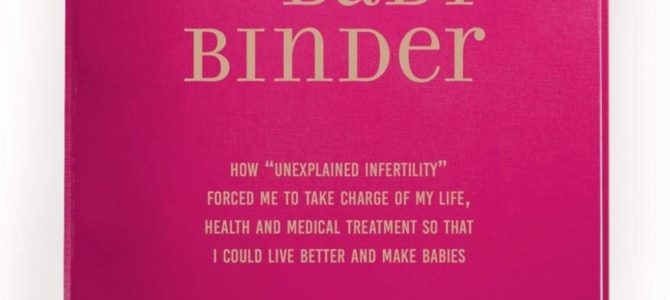
It’s not every day that a writer emails to say an article you wrote motivated her to finish writing a book. But such is the case with Callie Micks.
While on a writing hiatus, Micks apparently came across a book review I’d written about waiting for a better infertility memoir. She emailed, “I had a lot of starts and stops during the years-long creative process (my first time writing anything) . . . I often got stalled thinking, ‘Who am I to spend three years writing a book? I am not a writer.’ When I read your article I thought, ‘Somebody out there needs me. Keep writing.’” For Micks, it wasn’t about writing a “better” memoir, but “tell[ing] a story I felt had never been told. One I certainly never read when I needed to hear these words.”
The result is an extended loving letter to Micks’ younger self and all the other women out there experiencing miscarriages or other fertility challenges. “The Baby Binder: How Unexplained Infertility Forced Me to Take Charge of My Life, Health and Medical Treatment So That I Could Live Better and Make Babies” is a different sort of infertility memoir because it’s so intensely personal. Writing it helped Micks heal, and she hopes reading her book can do the same for others.
Pain and Fear
Micks paints with her words, comparing an infertility support group meeting to the women’s group in “Jerry Maguire.” “Except this was real. I was standing on sacred ground. The heartbreak, the worry, the tears . . . this was real life, and no heartthrob was coming to save us.”
She also candidly describes the pain and fear that can accompany a fertility journey. Micks embraces the reader, trusting us with her most personal thoughts and sharing what it was like to experience five years of unexplained infertility and more than a dozen miscarriages on the way to her happy ending, which in this case is becoming the mother of three.
We accompany Micks as overcomes her initial fear of needles and becomes a “fertility junkie.” We even travel with Micks, as she visits Mexico to undergo a fertility treatment banned by the U.S. Food and Drug Administration.
We learn about the physical pain of testing fallopian tube function with injected dye: “I felt brutalized. My insides felt raw and stretched, still throbbing.” Micks shares what it’s like to be betrayed by your own body as “gobs and gobs of hair” fall out, broadcasting details a woman might prefer to keep private.
We also hear about the emotional pain, including “the dismissive attitude that would define most of my fertility journey. My miscarriages were typically met with eye rolls, shrugs, a wave of the hand and a change of the subject,” as if these miscarriages weren’t real losses to be grieved.
Micks rightly observes at the start that “knowledge has to make friends with luck and mystery to bring a healthy baby into this world.” That is undoubtedly true and reflects Micks’ learning not only to trust her intuition, but also to advocate for herself as she perseveres, visiting numerous OB-GYNs, acupuncturists, chiropractors, and other fertility experts.
“It takes courage and resilience to follow your curiosity,” Micks writes, “to keep putting your faith in one more person, one more solution, even after everything you’ve tried so far has failed.”
Curiosity and Loneliness
Like the other two fertility memoirs I’ve reviewed for The Federalist, Micks shares her personal story. However, unlike the others, Micks’ doesn’t consciously place that story in a larger political, scientific, or bioethical context. This book is focused like a laser on Micks’ journey and reads more like a peek into someone else’s diary.
In that sense, this book should appeal not only to adults working overtime to start or expand their families, but also to the friends and families of those living this struggle. It offers insight into both big-picture problems and smaller indignities that loved ones may not be able to fully articulate while still experiencing them.
Micks’ story takes on larger significance, though, as she asks important questions about miscarriage. Micks notes, “We live in a world where terms like ‘family first’ and ‘pro-life’ abound, but a baby dying spontaneously in a woman’s body . . . meh.”
Micks is frustrated at the complete lack of curiosity her OB-GYNs and fertility specialists display in the face of her repeated miscarriages. Of course, without understanding why, identifying the appropriate solution becomes that much harder. Micks makes us ponder why doctors aren’t more interested in studying the causes of miscarriage, and why OB-GYNs typically know little about infertility.
Micks also returns repeatedly to the theme of loneliness. In an era when a quarter of Americans say they lack people to confide in and where loneliness is increasingly epidemic, Micks’ story offers one tale that illuminates those trends. Early in her journey, Micks observes:
This is how infertility is fought. Alone. With a crash course tacked on to the end of an appointment with a doctor who you wish you didn’t have to see, didn’t tell anyone you were seeing. Alone enough that no one hears the deep breath you take when you’re facing the scariest thing you’ve ever done, and no one to brag to about your victories.
Later, Micks, who has a supportive husband and several women she confides in along the way, concludes: “It’s the catch-22 of infertility support. Even when you have a friend who understands, depending on them to meet your huge demands for emotional support could kill your friendship, and then you’d have no one. Either way, it’s lonely.”
Hopefully Micks’ memoir can help make that experience a little less lonely.









